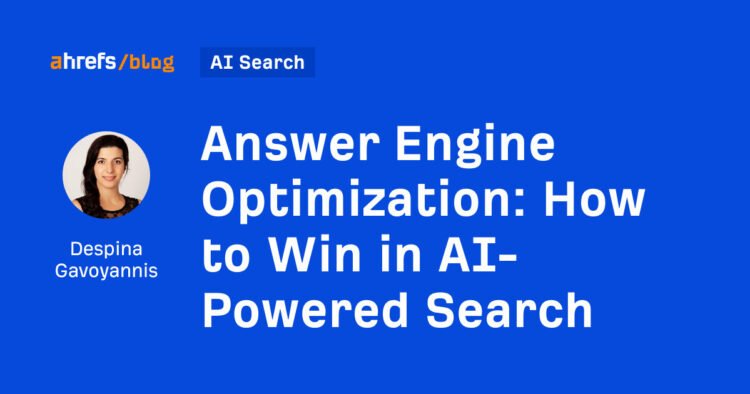Search is changing. People are no longer just “Googling it.” Increasingly, they’re asking AI systems for answers and getting them instantly without having to click and sift through different websites.
SEO is still essential for brands to show up in these answers, but visibility now depends on more than rankings. What matters is whether your brand and content are trusted and structured enough to be mentioned or cited.
This is where answer engine optimization comes in.
It builds on SEO fundamentals and adapts them for AI search, helping your brand become the answer wherever people are asking.
Answer engine optimization (AEO) is the practice of making your content visible and useful to AI systems that deliver direct answers, whether that’s Google’s AI Overviews, voice assistants, or LLMs like ChatGPT and Perplexity.
Unlike traditional SEO, which focuses on ranking web pages in search results, AEO is about being mentioned and cited directly in the answers generated by AI search platforms.
That requires content to be clear, structured, and trustworthy so that answer engines can easily extract and present it.
AEO vs traditional SEO
AEO doesn’t replace SEO; it complements it.
Both share the goal of making content discoverable, but they differ in how that content reaches people. SEO is still about ranking pages in organic search results. However, AEO is specifically about being cited or mentioned in AI answers, where there may not even be a list of links to click.
| AEO | SEO | |
|---|---|---|
| Primary goal | Surface your brand and content inside AI-generated answers. | Rank pages in search results. |
| Content focus | Concise, declarative answers that AI can easily summarize. | Long-form, comprehensive pages that send ranking signals. |
| Query targeting | Question-based and informational queries, often “1 of 1” searches, unique to LLMs. | Broad, high-volume queries, including local and transactional ones. |
| Technical elements | Avoid JavaScript reliance, use speakable and FAQ schema, and provide clean datasets and answers AI can extract directly. | Optimize on-page elements like meta tags, headings, and internal links. |
| Measurement | Track citations and mentions in AI Overviews, LLM responses, and chatbot conversations. | Track webpage rankings, clicks, and impressions. |
| User journey | Often delivers brand exposure without a click (zero-click visibility). | Encourages clicks to your site for deeper engagement. |
AEO is still grounded in SEO fundamentals. You need crawlable, optimized content to be seen in the first place.
But once the basics are covered, the focus shifts from ranking a page to packaging information in a way AI can trust and reuse.
The way people consume information is changing. Instead of clicking through multiple sites, they expect direct answers wherever they search.
This shift has several major implications for brands:
- Zero-click searches are becoming the norm. AI-generated answers often resolve a query on the spot. Even if users never visit your site, appearing in the cited answer can still build authority and brand recognition through search.
- Organic traffic is under pressure. Traditional rankings still matter, but clicks are no longer guaranteed. Visibility inside AI responses is now as critical as visibility in traditional search result pages.
- Business impact goes beyond SEO. When fewer visitors reach your website, the effects ripple through sales, product, and customer success teams. Therefore, protecting brand presence in AI answers ensures customers continue to encounter your expertise, even off-site.
- AI is shaping new user habits. Voice-ready answers and conversational interactions are still early, but they’re growing quickly. As AI assistants become part of everyday work and personal life, people will rely on them as default gateways to information.
In short, search experiences are moving from links to answers.
Brands that adapt with AEO can maintain visibility, authority, and customer trust in a landscape where traffic alone is no longer the only measure of success.
Getting started with AEO means shifting your mindset from ranking pages to being cited.
That requires targeting the right questions, structuring responses in a way answer engines can easily access, and strengthening the authority signals that make your brand a trustworthy source.
The steps below outline a practical process you can follow to build consistent visibility in AI-powered search results.
Step 1: See what AI is already saying about you
If you have an existing brand, use Ahrefs’ Brand Radar to see what AI is already saying about it.

In the AI responses tab, you’ll be able to see what different AI search platforms say about your brand:

You can also compare it to what they say about competitors and how much coverage you have in your market or niche.
Check out the AI answers provided for common queries. They’ll look like this:

If you see thousands of responses, it helps to filter them into smaller groups. For example, you could look at:
- Queries containing your brand to see what AI says about you for your branded searches.
- Queries containing a specific topic to see how strongly AI connects your brand to the topic.
- Queries containing a competitor’s name to see how often AI recommends your brand instead of (or alongside) the competitor.
Look for patterns in what AI answers say about you, especially when they get things wrong or when your branding is inconsistent. It helps to list these queries and the sources cited so you can work on overcoming the misinformation and brand inconsistencies.
Step 2: Fix incorrect information about your brand in AI Answers
If AI answers include incorrect details about your brand, it usually comes down to:
- Too little information on your website
- Inconsistent assets like logos, taglines, or messaging
- Misrepresentation by third-party content
- AI pulling from unreliable sources
Start by reviewing the queries where errors appear. Note what’s wrong and which sources were cited.
For brand-specific details (like your name, tagline, or mission statement), check your site and social profiles for consistency first. You can follow our brand SEO process to do this.
You may need to close content gaps on your website to correct more general misinformation about your brand.
For example, the query “what does Ahrefs stand for” produces a passable answer in Google’s AI Overviews, but it’s not a direct answer to the question.

It’s likely because there is no content on the website answering this exact question. So, if we wanted to make the answer more accurate, we could add a short FAQ to the page that’s cited in the AI response already. Something like:
What does Ahrefs stand for?
Ahrefs stands for “a href,” the HTML tag that creates hyperlinks in code. The name reflects the company’s origins in backlink analysis and highlights its focus on links, search visibility, and building tools that help websites improve SEO performance.
If your site has no information on a query, publish a new page or section to fill the gap. Here’s a helpful workflow for this:

You’re aiming to either add content or rewrite it so it’s AI-friendly.
- Use declarative sentences to communicate information clearly.
- Make the subject of each sentence clear.
- Add headings followed by direct answers. Don’t waffle.
- Share stories and anecdotes toward the end of the section.
If content exists but AI still incorrectly cites other sources, consider updating your content on third-party sites like G2, YouTube, Google Business, and more.
For example, Common Room is a brand that undertook such a task, and here’s what worked for them:

Otherwise, you can also try outreach. Contact the cited authors and offer updated, accurate information to ensure your brand is represented correctly. It’s slower, but worthwhile if misinformation risks confusing or losing clients.
Step 3: Close topic gaps to win visibility for new queries
Once you know what topics and queries you already have great visibility for, the next step is to find relevant queries featuring AI answers that you’re currently not showing up in.
Using Brand Radar to check out your competitor’s visibility is an easy way to start.

The Overview tab will show your brand against your competitors. You can assess each brand’s AI visibility by metrics like mentions, impressions, and AI Share of Voice.
You can also see a platform breakdown to assess visibility in any AI search tools that matter most to you.

When you click into each platform, you’ll be able to access the exact AI responses that mention each brand:

- Only brand: This report will show you queries and AI answers where the only brand mentioned is the one you’ve selected. It is great for assessing brand-specific queries and responses.
- With others: This report shows queries and/or responses that contain all the brands you’re comparing. It is great for assessing topics that are likely to mention you alongside competitors.
- Others only: This report shows queries that only mention the other brands you’re comparing against. It is great for finding topics that mention your competitors but not you.
For the purpose of finding topic gaps, start with the “Others only” report to see all the queries that do not mention your brand and favor competitors instead. Adding content to your website for these topics will help you close gaps against competitors right away.
But you can also go further and find topics your competitors have yet to discover. This will give you a competitive edge by closing the topic gap first.
I like to use Brand Radar and only enter my main topic:

Then, check out the AI responses report for queries and answers for each AI search platform you care about showing up on. You can also filter the queries or responses to exclude your brand and competitors.

You’ll be left with a list of untapped queries in your niche that you can create content for to gain more AI visibility before your competitors.
Step 4: Optimize content for direct, speakable answers
Once you’ve identified the right queries, the next step is structuring your content so answer engines can easily lift and reuse it.
If you’ve already been structuring your content following SEO best practices, there won’t be much you need to change in your workflow here.
- Use Q&A formats where it makes sense. Posing a question as a heading and immediately following it with a clear, concise answer helps AI systems match intent and extract information directly. Just don’t overdo it, as it can disrupt the reading flow for human readers.
- Write in declarative sentences. Confident, straightforward statements reduce ambiguity and make it easier for AI to reuse your content without distortion.
- Keep answers short, but not shallow. Lead with a crisp summary, prioritizing the bottom line up front, then expand with supporting context, examples, or anecdotes. This way, AI can cite the summary while readers still get depth.
- Structure content for readability. Use headings, tables, bullet points, and short paragraphs to create scannable sections. Think of each block as something that could stand alone in an AI response.
- Prioritize information gain. Go beyond surface-level definitions. Provide unique insights, context, or data that make your content more valuable and more likely to be chosen for AI answers over generic alternatives.
A common misconception is that you need to “chunk” content specifically for AI. While chunking content has been used as a technique for structured writing since the 1960s (at least), you don’t need to do anything extra to improve AI visibility.
If your content is written clearly, structured logically, and provides genuine information gain, AI systems will be able to handle the segmentation themselves.
Check out our guide on chunk optimization for more details and a helpful workflow you can follow.
Step 5: Implement technical AEO strategies
Technical foundations still matter for AEO. Answer engines rely on structured, crawlable data to understand your content and decide whether to cite it.
While many of these overlap with traditional SEO, the emphasis shifts toward clarity and machine readability.
An effective way to guide AI systems is through schema markup.
Sidenote.
Currently, it is unclear whether all AI search systems use schema markup. However, traditional search engines like Google have used it for years.
It is also an easy way to convert your content into structured data that makes it easier for AI search platforms to retrieve and interpret information.
TL;DR, even if it’s not used by all platforms right now, it also doesn’t hurt.
Implementing schema types like Article, FAQPage, HowTo, LocalBusiness, and Speakable helps machines recognize the most important pieces of information. Here’s an example offered by Google:

When structured properly, schema provides context that makes your content easier to extract and reuse in direct answers.
Equally important is ensuring crawlability and performance. Sites that load quickly, avoid heavy JavaScript reliance, and maintain a logical internal structure make it easier for AI engines to parse information.
These technical hygiene factors can be the difference between your content being cited or ignored.
Recommended reading
Step 6: Build authority & off-site signals
Answer engines don’t just look at what’s on your website. They also weigh how the wider web perceives your brand.
If you want AI systems to mention your brand or cite your content, you need to demonstrate authority within and beyond your own website. You can strengthen these signals by focusing on:
- E-E-A-T factors: Showcase experience, expertise, authority, and trust with detailed author bios, visible credentials, and fact-checked content on and off your website.
- Backlinks and citations: Earn links from reputable domains in your niche, and analyze which sites are most frequently mentioned and cited so you can target them directly.
- Co-mentions with trusted entities: Aim to have your brand mentioned alongside well-known names or organizations. LLMs can interpret these associations as signals of credibility.
- Third-party platforms: Keep your information consistent across directories, review sites, and industry publications. These external data points often feed into AI training sets.
Taken together, these signals expand your authority footprint beyond your own website. The stronger your presence across the wider web, the more likely answer engines are to recognize and cite your brand.
An easy way to earn more relevant links and mentions is to find pages that are frequently cited in AI answers.
If you want to build more links and mentions in resources that are frequently cited in AI responses, check out the Cited domains and Cited pages reports in Brand Radar:

You can check these out for competitors to find publications that mention them and are likely to also mention you. You can also try it out for websites that frequently write about your core topic.
You’ll get a list of websites or pages frequently appearing in AI answers.

AI search platforms often visit these pages and summarize their content.
Showing up here will reasonably quickly expose your brand to more AI search platforms and earn you more mentions in the answers they generate.
But you also want to be strategic about it.
Getting mentioned alongside your core topic or big brands in your industry will have a far bigger impact than your brand being tacked on at the end of the article. So, take the time to read the content and identify the most strategic place to feature your brand within it before you do any outreach.
Step 7: Monitor, measure & refine
Answer engine optimization isn’t a one-and-done project. AI platforms change quickly, and the only way to stay visible is to track your performance and adapt continually.
Start by monitoring where your brand is cited.
Tools like Brand Radar or other AI overview trackers can show you how you’re visibility improves or declines over time:

It also helps to track:
- Changes in which queries surface your brand or content
- Changes in which competitors are mentioned
- Changes in responses for queries with incorrect information about your brand
Pair this with tools like Ahrefs’ Web Analytics to measure visitors to your website that come from organic and AI search results.
![]()
Connecting this data back to your broader SEO and marketing metrics ensures AEO efforts contribute to business impact.
How long does answer engine optimization take?
From what I’ve seen, AEO typically takes weeks to months for established brands and 12–18 months for new brands with little online authority.
Established sites with strong SEO foundations can quickly see early wins by fixing brand inconsistencies, closing topic gaps, and improving third-party brand mentions. These adjustments help AI search platforms trust and cite your content sooner.
New or lesser-known brands face a longer timeline because they often need to build a solid SEO foundation before they can generate reliable mentions in AI responses.
Building credibility requires steady publication of high-quality content, consistent authority signals, and off-site mentions. Without that groundwork, it’s difficult to earn visibility in AI answers.
Answer engines are still evolving, and the way they surface information will continue to shift. A few key trends are already taking shape:
- Deeper integration of generative AI in search. Features like Google’s AI Mode are still in early stages. Expect broader rollouts and richer formats that pull in more structured content.
- Personalization of answers. As context windows expand and models gain more memory, AI systems will tailor responses more closely to individual users, making brand trust and accuracy even more critical.
- Rising importance of structured data. All major AI companies are hungry for reliable data sets. Brands that publish well-structured, high-quality information might have an edge in being cited.
- Monetization and bias. Platforms may increasingly favor their own products or paid partners in AI results. This will pressure brands to identify the queries and opportunities still available for organic visibility.
In short, AEO will become less about gaming search systems and more about supplying clear, trusted information that AI search platforms can rely on. Brands that prepare now will be best positioned as these trends accelerate.
Final thoughts
As search shifts toward AI-generated answers, visibility depends on more than rankings. Brands need to be recognized as trusted sources that answer engines can cite directly.
AEO builds on a solid SEO foundation, making it a specialized subset of SEO rather than a replacement.
Start small, track results, and refine over time. Early adopters gain an edge, but lasting visibility belongs to brands that treat AEO as an ongoing process.
To simplify this process, check out Ahrefs’ Brand Radar, the AEO platform for researching, analyzing, and monitoring your visibility in AI search responses.















